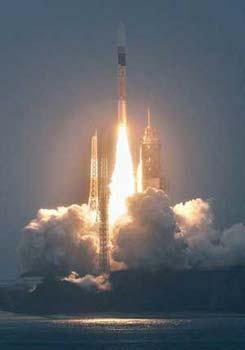Source: Xinhua
01-24-2009 11:41
Special Report: Tech MaxTOKYO, Jan. 23 (Xinhua) -- Japan launched Friday a rocket carrying a satellite aiming at studying the concentration of greenhouse gases in the Earth's atmosphere, as well as seven small satellites, including those developed by university students.
 |
| H-2A rocket No. 15 (H-2A F15) carrying Japan Aerospace Exploration Agency (JAXA) Greenhouse Gases Observing Satellite (GOSAT), known as "Ibuki" in Japan, blasts off from the southern island of Tanegashima Jan. 23, 2009.(Xinhua/Reuters Photo) |
The domestically built H-2A rocket carrying the Ibuki satellite was launched from the Tanegashima Space Center in Kagoshima Prefecture, Kyodo News reported.
The satellite will orbit the Earth at an altitude of some 666 kilometers, where it will obtain data once every three days concerning the levels of carbon dioxide and methane from 56,000 locations around the globe for about five years.
Of the seven small satellites, six were developed privately or by universities and one is a technology demonstration satellite developed by the aerospace agency to study new communications functions.
The Ibuki satellite will become the first of its kind to observe the concentration of greenhouse gases from space.
